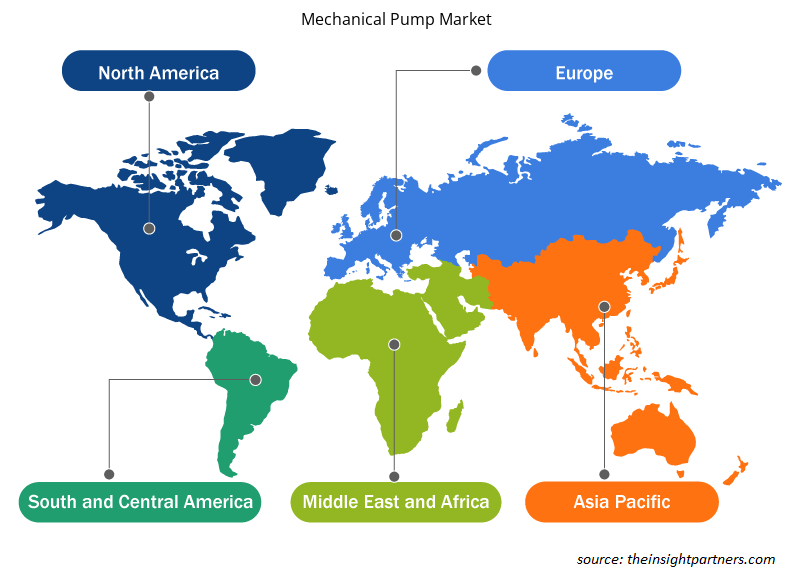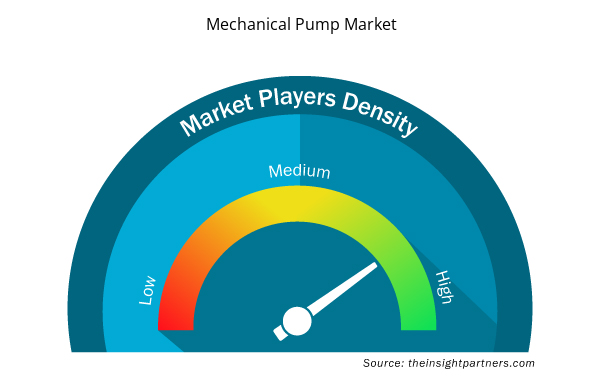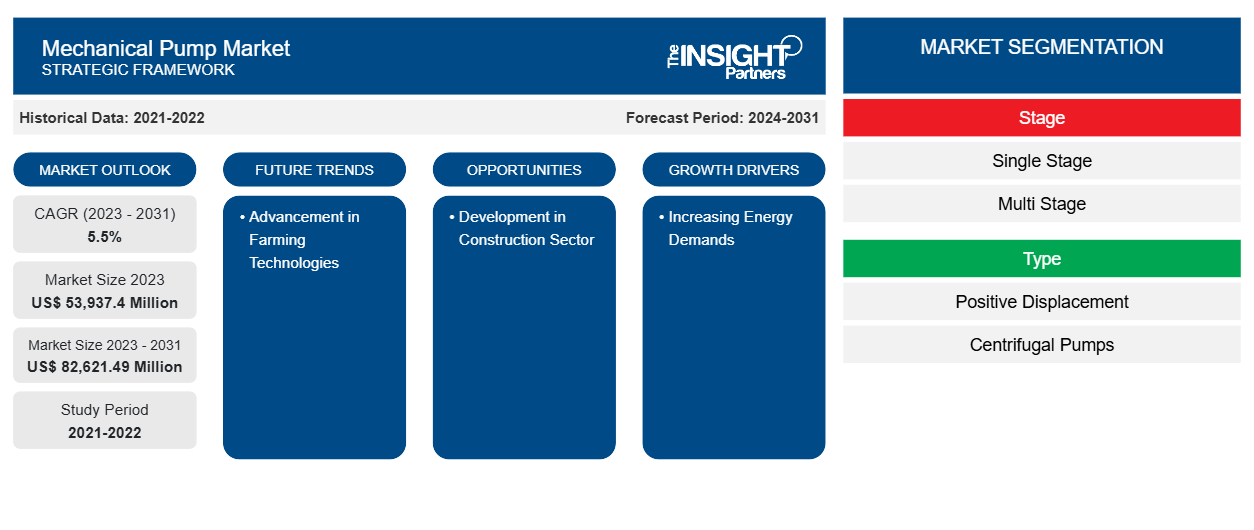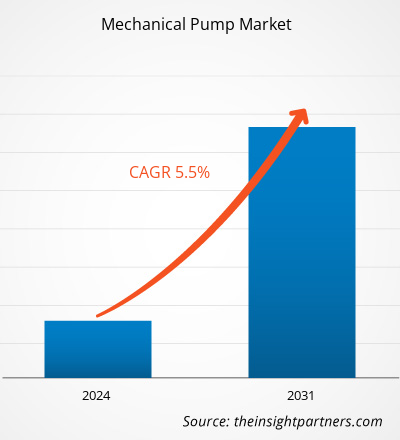Der Markt für mechanische Pumpen wird voraussichtlich von 53.937,4 Millionen US-Dollar im Jahr 2023 auf 82.621,49 Millionen US-Dollar im Jahr 2031 anwachsen. Der Markt wird im Zeitraum 2023–2031 voraussichtlich eine durchschnittliche jährliche Wachstumsrate von 5,5 % verzeichnen. Der wachsende Fortschritt in der Agrartechnologie wird wahrscheinlich ein wichtiger Trend auf dem Markt bleiben.
Marktanalyse für mechanische Pumpen
Zu diesen Interessenvertretern des Marktes für mechanische Pumpen zählen unter anderem Regierungsbehörden, Industrieverbände und Aufsichtsbehörden, wie etwa die Indian Pump Manufacturers' Association (IPMA), die British Pump Manufacturers' Association (BPMA), Europump (die europäische Vereinigung der Pumpenhersteller) und das Hydraulic Institute (HI). Zu den Endverbrauchern mechanischer Pumpen zählen unter anderem Branchen wie Chemie, Öl und Gas sowie Petrochemie, Bergbau, Stromerzeugung, Automobilindustrie, Landwirtschaft, Heizungs-, Lüftungs- und Klimatechnik und Abwassermanagement.
Marktübersicht für mechanische Pumpen
Zu den wichtigsten Akteuren im globalen Ökosystem des Marktes für mechanische Pumpen gehören Hersteller mechanischer Pumpen, Regierungsbehörden, Industrieverbände, Regulierungsbehörden, Lieferanten/Händler und Endverbraucher. Einige der wichtigsten Hersteller mechanischer Pumpen, die in diesem Bericht aufgeführt sind, sind Grundfos Holding A/S, Kirloskar Brothers Limited, KSB SE & Co. KGaA, Ebara Corporation, Sulzer Ltd, Pleuger Industries, The Weir Group PLC, Wilo SE, Tsurumi Manufacturing Co., Ltd. und Xylem Inc., um nur einige zu nennen. Neben diesen wichtigen Akteuren im Ökosystem spielen mehrere periphere Akteure im globalen Markt für mechanische Pumpen eine wichtige Rolle, um die Akzeptanz dieser Maschinen bei den Endverbrauchern zu ermöglichen und technologische Fortschritte für ein nachhaltiges zukünftiges Wachstum des Marktes zu fördern.
Passen Sie diesen Bericht Ihren Anforderungen an
Sie erhalten kostenlos individuelle Anpassungen an jedem Bericht, einschließlich Teilen dieses Berichts oder einer Analyse auf Länderebene, eines Excel-Datenpakets sowie tolle Angebote und Rabatte für Start-ups und Universitäten.
- Holen Sie sich die wichtigsten Markttrends aus diesem Bericht.Dieses KOSTENLOSE Beispiel umfasst eine Datenanalyse von Markttrends bis hin zu Schätzungen und Prognosen.
Treiber und Chancen auf dem Markt für mechanische Pumpen
Steigender Energiebedarf der Marktteilnehmer begünstigt den Markt
Der wachsende Energiebedarf und die zunehmende Anforderung an eine unterbrechungsfreie Energieversorgung im gewerblichen und industriellen Sektor treiben den Bedarf an zusätzlicher Energieinfrastruktur voran. Wasser spielt bei der Stromerzeugung in diesen Anlagen eine Schlüsselrolle, da es in Dampf umgewandelt wird, um die Turbinen anzutreiben. In diesen Kraftwerken werden mechanische Pumpen zur Wasserzirkulation eingesetzt. Aufgrund der wachsenden Bevölkerung, Industrialisierung und Urbanisierung weltweit, insbesondere im asiatisch-pazifischen Raum, steigt der Energiebedarf rasant an. Infolgedessen werden weltweit mehrere Kraftwerke mit fossilen Brennstoffen eingesetzt. Darüber hinaus befindet sich die Stromerzeugung aus erneuerbaren Energiequellen in einem frühen Stadium und wird vor allem in Nordamerika und Europa betont. Der wachsende Energiebedarf und die damit einhergehende Steigerung der Stromerzeugungsaktivitäten kurbeln also das Wachstum des Marktes für mechanische Pumpen an.
Entwicklung im Bausektor
Mehrere ausländische Akteure verlagern ihre Produktionsstätten in Entwicklungsländer im asiatisch-pazifischen Raum, um von den niedrigen Arbeitskosten zu profitieren, was den industriellen Bau weiter vorantreiben soll. Angesichts der stetigen Zunahme der Bautätigkeiten weltweit wird erwartet, dass der Markt für mechanische Pumpen im Prognosezeitraum weiter wächst. Das Wachstum dieses Sektors ist hauptsächlich auf die zunehmende städtische Bevölkerung zurückzuführen, die durch einen Anstieg des Lebensstandards unterstützt wird. Auch der Anstieg des gewerblichen Baus, beispielsweise von Freizeitzentren, Kinosälen, Einkaufszentren, Krankenhäusern, Sportarenen und Bürogebäuden, treibt die Ausbreitung dieses Sektors weiter voran. Schwellenländer ergreifen verschiedene Initiativen, um die Industrialisierung voranzutreiben, indem sie günstige Geschäftsumgebungen für internationale Investoren schaffen und gleichzeitig das Wachstum der lokalen Fertigung unterstützen, was im Prognosezeitraum die Nachfrage nach mechanischen Pumpen ankurbeln soll.
Segmentierungsanalyse des Marktberichts für mechanische Pumpen
Wichtige Segmente, die zur Ableitung der Marktanalyse für mechanische Pumpen beigetragen haben, sind Stadium, Typ und Anwendung.
- Basierend auf der Stufe ist der Markt für mechanische Pumpen in einstufig und mehrstufig unterteilt. Das einstufige Segment hatte im Jahr 2023 einen größeren Marktanteil.
- Basierend auf dem Typ ist der Markt für mechanische Pumpen in Verdrängerpumpen und Kreiselpumpen unterteilt. Das Segment der Kreiselpumpen hatte im Jahr 2023 einen größeren Marktanteil.
- Basierend auf der Anwendung ist der Markt für mechanische Pumpen in Industrie-, Gewerbe- und Wohnpumpen unterteilt. Das Industriesegment hatte im Jahr 2023 einen größeren Marktanteil.
Marktanteilsanalyse für mechanische Pumpen nach Geografie
Der geografische Umfang des Marktberichts für mechanische Pumpen ist hauptsächlich in fünf Regionen unterteilt: Nordamerika, Asien-Pazifik, Europa, Naher Osten und Afrika sowie Süd- und Mittelamerika.
Der Umfang des Marktberichts für mechanische Pumpen umfasst Nordamerika (USA, Kanada und Mexiko), Europa (Russland, Großbritannien, Deutschland, Frankreich, Italien und den Rest Europas), den asiatisch-pazifischen Raum (Südkorea, Indien, Australien, Japan, China und den Rest des asiatisch-pazifischen Raums), den Nahen Osten und Afrika (Südafrika, Saudi-Arabien, die Vereinigten Arabischen Emirate und den Rest des Nahen Ostens und Afrikas) sowie Süd- und Mittelamerika (Argentinien, Brasilien und den Rest Süd- und Mittelamerikas). In Bezug auf den Umsatz dominierte der asiatisch-pazifische Raum im Jahr 2023 den Marktanteil mechanischer Pumpen. Nordamerika ist der zweitgrößte Beitragszahler zum globalen Markt für mechanische Pumpen, gefolgt von Europa.
Regionale Einblicke in den Markt für mechanische Pumpen
Die regionalen Trends und Faktoren, die den Markt für mechanische Pumpen im Prognosezeitraum beeinflussen, wurden von den Analysten von Insight Partners ausführlich erläutert. In diesem Abschnitt werden auch die Marktsegmente und die Geografie mechanischer Pumpen in Nordamerika, Europa, im asiatisch-pazifischen Raum, im Nahen Osten und Afrika sowie in Süd- und Mittelamerika erörtert.

- Erhalten Sie regionale Daten zum Markt für mechanische Pumpen
Umfang des Marktberichts über mechanische Pumpen
| Berichtsattribut | Details |
|---|---|
| Marktgröße im Jahr 2023 | 53.937,4 Millionen US-Dollar |
| Marktgröße bis 2031 | 82.621,49 Millionen US-Dollar |
| Globale CAGR (2023 - 2031) | 5,5 % |
| Historische Daten | 2021-2022 |
| Prognosezeitraum | 2024–2031 |
| Abgedeckte Segmente | Nach Phase
|
| Abgedeckte Regionen und Länder | Nordamerika
|
| Marktführer und wichtige Unternehmensprofile |
|
Dichte der Marktteilnehmer für mechanische Pumpen: Deren Auswirkungen auf die Geschäftsdynamik verstehen
Der Markt für mechanische Pumpen wächst rasant, angetrieben durch die steigende Nachfrage der Endnutzer aufgrund von Faktoren wie sich entwickelnden Verbraucherpräferenzen, technologischen Fortschritten und einem größeren Bewusstsein für die Vorteile des Produkts. Mit steigender Nachfrage erweitern Unternehmen ihr Angebot, entwickeln Innovationen, um die Bedürfnisse der Verbraucher zu erfüllen, und nutzen neue Trends, was das Marktwachstum weiter ankurbelt.
Die Marktteilnehmerdichte bezieht sich auf die Verteilung der Firmen oder Unternehmen, die in einem bestimmten Markt oder einer bestimmten Branche tätig sind. Sie gibt an, wie viele Wettbewerber (Marktteilnehmer) in einem bestimmten Marktraum im Verhältnis zu seiner Größe oder seinem gesamten Marktwert präsent sind.
Die wichtigsten auf dem Markt für mechanische Pumpen tätigen Unternehmen sind:
- EBARA CORPORATION
- Grundfos Holding A/S
- KIRLOSKAR BROTHERS LIMITED
- KSB SE & Co. KGaA
- PLEUGER INDUSTRIES
- Sulzer Ltd
Haftungsausschluss : Die oben aufgeführten Unternehmen sind nicht in einer bestimmten Reihenfolge aufgeführt.

- Überblick über die wichtigsten Akteure auf dem Markt für mechanische Pumpen
Neuigkeiten und aktuelle Entwicklungen auf dem Markt für mechanische Pumpen
Der Markt für mechanische Pumpen wird durch die Erhebung qualitativer und quantitativer Daten nach Primär- und Sekundärforschung bewertet, die wichtige Unternehmensveröffentlichungen, Verbandsdaten und Datenbanken umfasst. Nachfolgend sind einige der Entwicklungen auf dem Markt für mechanische Pumpen aufgeführt:
- EBARA Corporation Japan (EBARA) hat 100 % der Anteile an Hayward Gordon LP (Hayward Gordon) erworben. (Quelle: EBARA Corporation, Pressemitteilung, Oktober 2022)
- Grundfos Holding A/S, ein weltweit führender Anbieter fortschrittlicher Pumpenlösungen und Wassertechnologie, hat heute sein hochmodernes Werk in Serbien eingeweiht. (Quelle Grundfos Holding A/S, Pressemitteilung, September 2022)
Marktbericht zu mechanischen Pumpen – Abdeckung und Ergebnisse
Der Bericht „Marktgröße und Prognose für mechanische Pumpen (2021–2031)“ bietet eine detaillierte Analyse des Marktes, die die folgenden Bereiche abdeckt:
- Marktgröße und Prognose für mechanische Pumpen auf globaler, regionaler und Länderebene für alle wichtigen Marktsegmente, die im Rahmen des Berichts abgedeckt sind
- Markttrends für mechanische Pumpen sowie Marktdynamik wie Treiber, Einschränkungen und wichtige Chancen
- Detaillierte PEST- und SWOT-Analyse
- Marktanalyse für mechanische Pumpen, die wichtige Markttrends, globale und regionale Rahmenbedingungen, wichtige Akteure, Vorschriften und aktuelle Marktentwicklungen umfasst
- Branchenlandschaft und Wettbewerbsanalyse, die die Marktkonzentration, Heatmap-Analyse, prominente Akteure und aktuelle Entwicklungen für den Markt für mechanische Pumpen umfasst
- Detaillierte Firmenprofile
- Historische Analyse (2 Jahre), Basisjahr, Prognose (7 Jahre) mit CAGR
- PEST- und SWOT-Analyse
- Marktgröße Wert/Volumen – Global, Regional, Land
- Branche und Wettbewerbsumfeld
- Excel-Datensatz


- Electronic Shelf Label Market
- 3D Mapping and Modelling Market
- Vision Care Market
- Space Situational Awareness (SSA) Market
- Helicopters Market
- Adaptive Traffic Control System Market
- Aesthetic Medical Devices Market
- Cell Line Development Market
- Explosion-Proof Equipment Market
- Electronic Toll Collection System Market

Report Coverage
Revenue forecast, Company Analysis, Industry landscape, Growth factors, and Trends

Segment Covered
This text is related
to segments covered.

Regional Scope
North America, Europe, Asia Pacific, Middle East & Africa, South & Central America

Country Scope
This text is related
to country scope.
Häufig gestellte Fragen
Asia Pacific dominated the mechanical pump market in 2023.
The growing advancement in farming technologies is the future trend of the mechanical pump market.
Ebara Corporation, Kirloskar Brothers Limited, Grundfos Holding A/S, KSB SE & Co. KGaA, pleuger industries, Sulzer Ltd, The Weir Group PLC, WILO SE, Tsurumi Manufacturing Co., Ltd., and Xylem Inc. are some of the leading players in the market.
US$ 82,621.49 million estimated value of the mechanical pump market by 2031.
5.5% is the expected CAGR of the mechanical pump market.
Trends and growth analysis reports related to Manufacturing and Construction : READ MORE..
The Insight Partners performs research in 4 major stages: Data Collection & Secondary Research, Primary Research, Data Analysis and Data Triangulation & Final Review.
- Data Collection and Secondary Research:
As a market research and consulting firm operating from a decade, we have published and advised several client across the globe. First step for any study will start with an assessment of currently available data and insights from existing reports. Further, historical and current market information is collected from Investor Presentations, Annual Reports, SEC Filings, etc., and other information related to company’s performance and market positioning are gathered from Paid Databases (Factiva, Hoovers, and Reuters) and various other publications available in public domain.
Several associations trade associates, technical forums, institutes, societies and organization are accessed to gain technical as well as market related insights through their publications such as research papers, blogs and press releases related to the studies are referred to get cues about the market. Further, white papers, journals, magazines, and other news articles published in last 3 years are scrutinized and analyzed to understand the current market trends.
- Primary Research:
The primarily interview analysis comprise of data obtained from industry participants interview and answers to survey questions gathered by in-house primary team.
For primary research, interviews are conducted with industry experts/CEOs/Marketing Managers/VPs/Subject Matter Experts from both demand and supply side to get a 360-degree view of the market. The primary team conducts several interviews based on the complexity of the markets to understand the various market trends and dynamics which makes research more credible and precise.
A typical research interview fulfils the following functions:
- Provides first-hand information on the market size, market trends, growth trends, competitive landscape, and outlook
- Validates and strengthens in-house secondary research findings
- Develops the analysis team’s expertise and market understanding
Primary research involves email interactions and telephone interviews for each market, category, segment, and sub-segment across geographies. The participants who typically take part in such a process include, but are not limited to:
- Industry participants: VPs, business development managers, market intelligence managers and national sales managers
- Outside experts: Valuation experts, research analysts and key opinion leaders specializing in the electronics and semiconductor industry.
Below is the breakup of our primary respondents by company, designation, and region:

Once we receive the confirmation from primary research sources or primary respondents, we finalize the base year market estimation and forecast the data as per the macroeconomic and microeconomic factors assessed during data collection.
- Data Analysis:
Once data is validated through both secondary as well as primary respondents, we finalize the market estimations by hypothesis formulation and factor analysis at regional and country level.
- Macro-Economic Factor Analysis:
We analyse macroeconomic indicators such the gross domestic product (GDP), increase in the demand for goods and services across industries, technological advancement, regional economic growth, governmental policies, the influence of COVID-19, PEST analysis, and other aspects. This analysis aids in setting benchmarks for various nations/regions and approximating market splits. Additionally, the general trend of the aforementioned components aid in determining the market's development possibilities.
- Country Level Data:
Various factors that are especially aligned to the country are taken into account to determine the market size for a certain area and country, including the presence of vendors, such as headquarters and offices, the country's GDP, demand patterns, and industry growth. To comprehend the market dynamics for the nation, a number of growth variables, inhibitors, application areas, and current market trends are researched. The aforementioned elements aid in determining the country's overall market's growth potential.
- Company Profile:
The “Table of Contents” is formulated by listing and analyzing more than 25 - 30 companies operating in the market ecosystem across geographies. However, we profile only 10 companies as a standard practice in our syndicate reports. These 10 companies comprise leading, emerging, and regional players. Nonetheless, our analysis is not restricted to the 10 listed companies, we also analyze other companies present in the market to develop a holistic view and understand the prevailing trends. The “Company Profiles” section in the report covers key facts, business description, products & services, financial information, SWOT analysis, and key developments. The financial information presented is extracted from the annual reports and official documents of the publicly listed companies. Upon collecting the information for the sections of respective companies, we verify them via various primary sources and then compile the data in respective company profiles. The company level information helps us in deriving the base number as well as in forecasting the market size.
- Developing Base Number:
Aggregation of sales statistics (2020-2022) and macro-economic factor, and other secondary and primary research insights are utilized to arrive at base number and related market shares for 2022. The data gaps are identified in this step and relevant market data is analyzed, collected from paid primary interviews or databases. On finalizing the base year market size, forecasts are developed on the basis of macro-economic, industry and market growth factors and company level analysis.
- Data Triangulation and Final Review:
The market findings and base year market size calculations are validated from supply as well as demand side. Demand side validations are based on macro-economic factor analysis and benchmarks for respective regions and countries. In case of supply side validations, revenues of major companies are estimated (in case not available) based on industry benchmark, approximate number of employees, product portfolio, and primary interviews revenues are gathered. Further revenue from target product/service segment is assessed to avoid overshooting of market statistics. In case of heavy deviations between supply and demand side values, all thes steps are repeated to achieve synchronization.
We follow an iterative model, wherein we share our research findings with Subject Matter Experts (SME’s) and Key Opinion Leaders (KOLs) until consensus view of the market is not formulated – this model negates any drastic deviation in the opinions of experts. Only validated and universally acceptable research findings are quoted in our reports.
We have important check points that we use to validate our research findings – which we call – data triangulation, where we validate the information, we generate from secondary sources with primary interviews and then we re-validate with our internal data bases and Subject matter experts. This comprehensive model enables us to deliver high quality, reliable data in shortest possible time.


 Holen Sie sich ein kostenloses Muster für diesen Bericht
Holen Sie sich ein kostenloses Muster für diesen Bericht